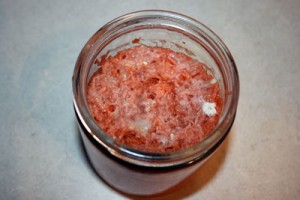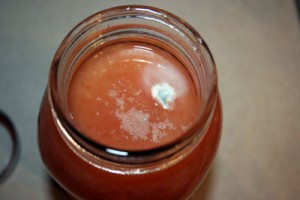FTC Disclosure: Delicious Obsessions may receive comissions from purchases made through links in this article. As an Amazon Associate I earn from qualifying purchases.Read our full terms and conditions here.

UPDATE 7/26/12: I no longer use whey as a starter for my ferments (learn why here). I also no longer use Mason jars for my ferments (learn why here). I use Fidos and Pickl-Its exclusively and the improvement in the taste and texture of my ferments is unbelievable! I encourage everyone to take a look at the information regarding Mason jar ferments and come to a decision that best fits their family. I will be releasing updated versions of these recipes soon, as it applies to the Fido and Pickl-It jars.
Welcome to Week 3 of the 52 Weeks of Bad A** Bacteria series. This week, I decided to dive into one of the most popular lacto-fermented foods — ginger carrots. If you’re new to fermented vegetables, this is a great way to introduce them to your palate. The flavor is mild, sweet, and a little warm from the ginger. Carrots are typically in season in the summer and fall and you’ll get the most flavorful varieties then. They are one of the veggies that I buy out of season, especially in the winter when I’m making lots of stock and stew. I had a 5 pound bag in my fridge and I decided that it was the perfect recipe to make this week.
The Common Carrot
We’re used to seeing carrots in orange, but did you know they do come in yellow, purple, red, and white? These varieties can usually be found at your seasonal farmers markets and they are wonderful. As a matter of fact, did you know that yellow, red, and purple carrots were the only varieties available before the 17th century?
In regards to nutrition, carrots do pack a good punch. In a 10 year study in the Netherlands, it was discovered that while all vegetable are important in preventing heart disease, vegetables in the orange and yellow families are the best. Carrots are typically known for their carotenoids, which act like antioxidents, but they also have another special phytonutrient called polyacetylenes. Some studies are showing that these specific nutrients play a roll in preventing colon cancer cell growth. There is a strong link between the carotenoids and the polyacetylenes regarding their ability to prevent oxidative damage in the body. I always say, it’s important to get our nutrition from our food, rather than supplements. If you were to take these two nutrients separately, then you would not gain the full benefit of them because they need to work synergistically to do their job.
Carrots are very high in beta-carotene, which is the precursor to vitamin A. Beta-carotene, which is found in many other vegetables, has to be converted in the intestines into vitamin A. If the body already has enough vitamin A floating around, then the conversion decreases as your body naturally regulates your vitamin levels. You cannot become toxic from beta-carotene, or food-based vitamin A, unlike synthetic vitamin A, which is dangerous. It is important to note that vitamin A from plant sources is not ideal. Because of the conversion that has to take place, it often is ineffective and you don’t get as much benefit from plant-based vitamin A as you do from meat-based (primarily organ meats) vitamin A.
Things Are Going Great, And Then ….
… there was mold!
GAH!

LF Ginger Carrots with Mold
Yes. I had my very first experience with fermented food and mold this week. It took me by surprise. In all of the stuff I’ve fermented over the years, I’ve never once had mold. Yet, when I went to check my jar of carrots, I pulled it off the shelf and low and behold, the top layer was a grayish white and there was a big clump of mold near the side of the jar. I immediately felt disappointed and slightly upset (though, I know this is just part of the process sometimes!). At the same time, I was happy that I had only made a tiny batch, so it wasn’t like I had to toss a ton. About 2 cups total probably. To top it off, I had tried to do a grapefruit version of last week’s LF orange juice and I ended up with mold on it too! Sigh. Apparently, it was not my week for fermenting. Good thing I had lots of kombucha and LF garlic to get me through!

LF Grapefruit Juice with Mold
Not sure how I got mold, considering I’ve never had it happen before. I sanitized the jar and the lid before I put the ginger carrots in there. The only explanation is that there was not enough liquid covering the carrots and it allowed mold to start growing. If I had weighted the carrots down with something, then they would have stayed submerged below the liquid and they would have been fine. But, alas, I learned a valuable lesson and I have already started changing my process for future ferments. In fact, I was fortunate enough to meet one of my readers this last week when I delivered a scoby to her so she could start brewing her own kombucha, and she surprised me by giving me an airlock jar for my ferments. I’m so excited to try it! Anyone here used an airlock?
For those of you who want to try the ginger carrots, they really are delicious, despite my fuzzy escapade this week. I made a batch about a year ago and they were quite tasty. Here is the recipe I followed, which is out of Nourishing Traditions.
Ginger Carrots
Nourishing Traditions, page 95
Makes 1 quart
4 cups grated carrots
1 tbsp. fresh grated ginger
1 tbsp. salt
4 tbsps. whey (if not available, use an additional tbsp. of salt)
Shred the carrots and place in a bowl with the other ingredients. Now comes the hard part. You need to get all the juices to release. I used a meat mallet with a baggie over it (mine is metal). You can also use a wooden pounder if you have one. You have to mash and mash and mash until you have a decent amount of juice in the bowl. Then, take all of the ingredients and place in a wide-mouthed quart jar (I always sanitize mine in boiling water first). Press the carrots down until they’re tightly packed and the liquid is approximately one inch above the carrots. Also, leave one inch of space between the top of the liquid and the top of the jar.
Leave a room temperature for 3-5 days and then move to cold storage.
Important note: Make sure you check each day to see if the liquid is covering the carrots. If not, press the carrots back down so they are submerged. This is where I messed up. The carrots were completely out of the liquid. Sandor Katz (author of Wild Fermentation – if you haven’t read it, I HIGHLY recommend it), uses weights of some sort to keep the top of the veggies submerged. I’m going to have to play with this and see what works. I’ll report back in next week’s post.
So, there you go. Have you had any experience with molds in your fermented foods? Have you ever used an airlock? Have you used weights of some sort on your ferments to keep the vegetables submerged? I’d love to hear your feedback!
Sources: WHFoods.com – “Carrots” | Nourishing Traditions, page 95 | World Carrot Museum

17 Comments